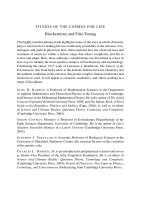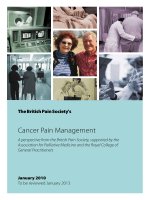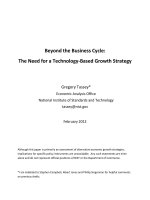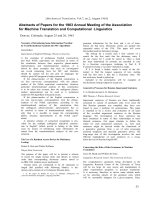The fearless organization creating psychological safety in the workplace for learning, innovation, and growth
Bạn đang xem bản rút gọn của tài liệu. Xem và tải ngay bản đầy đủ của tài liệu tại đây (1.28 MB, 258 trang )
the
fearless
organization
the
fearless
organization
Creating Psychological Safety in the
Workplace for Learning,
Innovation, and Growth
Amy C. Edmondson
HARVARD BUSINESS SCHOOL
Copyright © 2019 by John Wiley & Sons, Inc. All rights reserved.
Published by John Wiley & Sons, Inc., Hoboken, New Jersey.
Published simultaneously in Canada.
No part of this publication may be reproduced, stored in a retrieval system, or transmitted in any form
or by any means, electronic, mechanical, photocopying, recording, scanning, or otherwise, except as
permitted under Section 107 or 108 of the 1976 United States Copyright Act, without either the
prior written permission of the Publisher, or authorization through payment of the appropriate
per-copy fee to the Copyright Clearance Center, Inc., 222 Rosewood Drive, Danvers, MA 01923,
(978) 750-8400, fax (978) 646-8600, or on the Web at www.copyright.com. Requests to the
Publisher for permission should be addressed to the Permissions Department, John Wiley & Sons, Inc.,
111 River Street, Hoboken, NJ 07030, (201) 748-6011, fax (201) 748-6008, or online at http://www
.wiley.com/go/permissions.
Limit of Liability/Disclaimer of Warranty: While the publisher and author have used their best efforts
in preparing this book, they make no representations or warranties with respect to the accuracy or
completeness of the contents of this book and specifically disclaim any implied warranties of
merchantability or fitness for a particular purpose. No warranty may be created or extended by sales
representatives or written sales materials. The advice and strategies contained herein may not be
suitable for your situation. You should consult with a professional where appropriate. Neither the
publisher nor author shall be liable for any loss of profit or any other commercial damages, including
but not limited to special, incidental, consequential, or other damages.
For general information on our other products and services or for technical support, please contact our
Customer Care Department within the United States at (800) 762-2974, outside the United States at
(317) 572-3993 or fax (317) 572-4002.
Wiley publishes in a variety of print and electronic formats and by print-on-demand. Some material
included with standard print versions of this book may not be included in e-books or in
print-on-demand. If this book refers to media such as a CD or DVD that is not included in the
version you purchased, you may download this material at . For more
information about Wiley products, visit www.wiley.com.
Library of Congress Cataloging-in-Publication Data
Names: Edmondson, Amy C., author.
Title: The fearless organization : creating psychological safety in the
workplace for learning, innovation, and growth / Amy C. Edmondson.
Description: Hoboken, New Jersey : John Wiley & Sons, Inc., [2019] | Includes
index. |
Identifiers: LCCN 2018033732 (print) | LCCN 2018036160 (ebook) | ISBN
9781119477228 (Adobe PDF) | ISBN 9781119477266 (ePub) | ISBN 9781119477242
(hardcover)
Subjects: LCSH: Organizational behavior. | Organizational
learning—Psychological aspects. | Psychology, Industrial.
Classification: LCC HD58.7 (ebook) | LCC HD58.7 .E287 2019 (print) | DDC
658.3/82—dc23
LC record available at />Cover Design: Wiley
Printed in the United States of America
10 9 8 7 6 5 4 3 2 1
To George
Whose curiosity and passion make him a great scientist and
leader – and who knows all too well that fear is the enemy
of flourishing.
Brief Contents
Introduction
xiii
PART I
The Power of Psychological Safety
1
Chapter 1
The Underpinning
3
Chapter 2
The Paper Trail
25
PART II
Psychological Safety at Work
51
Chapter 3
Avoidable Failure
53
Chapter 4
Dangerous Silence
77
Chapter 5
The Fearless Workplace
103
Chapter 6
Safe and Sound
129
PART III
Creating a Fearless Organization
151
Chapter 7
Making it Happen
153
Chapter 8
What’s Next?
187
vii
viii
Brief Contents
Appendix: Variations in survey measures to Illustrate Robustness
of Psychological Safety
213
Acknowledgments
217
About the Author
219
Index
221
Contents
Introduction
xiii
What It Takes to Thrive in a Complex, Uncertain
World
Discovery by Mistake
Overview of the Book
Endnotes
PART I
The Power of Psychological Safety
Chapter 1
The Underpinning
Unconscious Calculators
Envisioning the Psychologically Safe Workplace
An Accidental Discovery
Standing on Giants’ Shoulders
Why Fear Is Not an Effective Motivator
What Psychological Safety Is Not
Measuring Psychological Safety
Psychological Safety Is Not Enough
Endnotes
ix
xiii
xvi
xviii
xxi
1
3
4
6
8
12
13
15
19
21
22
x
Chapter 2
Contents
The Paper Trail
Not a Perk
The Research
An Epidemic of Silence
A Work Environment that Supports Learning
Why Psychological Safety Matters for Performance
Psychologically Safe Employees Are Engaged
Employees
Psychological Safety as the Extra Ingredient
Bringing Research to Practice
Endnotes
25
26
29
30
35
39
PART II
Psychological Safety at Work
51
Chapter 3
Avoidable Failure
Exacting Standards
Stretching the Stretch Goal
Fearing the Truth
Who Regulates the Regulators?
Avoiding Avoidable Failure
Adopting an Agile Approach to Strategy
Endnotes
53
54
60
63
66
68
70
72
Chapter 4
Dangerous Silence
Failing to Speak Up
What Was Not Said
Excessive Confidence in Authority
A Culture of Silence
Silence in the Noisy Age of Social Media
Endnotes
77
78
79
83
86
92
97
41
43
45
46
Contents
Chapter 5
xi
The Fearless Workplace
Making Candor Real
Extreme Candor
Be a Don’t Knower
When Failure Works
Caring for Employees
Learning from Psychologically Safe Work
Environments
Endnotes
103
104
109
113
116
119
Chapter 6
Safe and Sound
Use Your Words
One for All and All for One
Speaking Up for Worker Safety
Transparency by Whiteboard
Unleashing Talent
Endnotes
129
130
135
138
142
146
147
PART III
Creating a Fearless Organization
151
Chapter 7
Making it Happen
The Leader’s Tool Kit
How to Set the Stage for Psychological Safety
How to Invite Participation So People Respond
How to Respond Productively to Voice – No Matter
Its Quality
Leadership Self-Assessment
Endnotes
153
154
158
167
What’s Next?
Continuous Renewal
Deliberative Decision-Making
187
187
189
Chapter 8
123
124
173
181
183
xii
Contents
Hearing the Sounds of Silence
When Humor Isn’t Funny
Psychological Safety FAQs
Tacking Upwind
Endnotes
191
193
195
208
209
Appendix: Variations in survey measures to Illustrate Robustness
of Psychological Safety
213
Acknowledgments
217
About the Author
219
Index
221
Introduction
“No passion so effectively robs the mind of all its powers of acting and reasoning
as fear.”
—Edmund Burke, 1756.1
Whether you lead a global corporation, develop software, advise
clients, practice medicine, build homes, or work in one of today’s
state-of-the-art factories that require sophisticated computer skills
to manage complex production challenges, you are a knowledge
worker.2 Just as the engine of growth in the Industrial Revolution
was standardization, with workers as laboring bodies confined to
execute “the one best way” to get almost any task done, growth
today is driven by ideas and ingenuity. People must bring their brains
to work and collaborate with each other to solve problems and
accomplish work that’s perpetually changing. Organizations must
find, and keep finding, new ways to create value to thrive over the
long term. And creating value starts with putting the talent you have
to its best and highest use.
What It Takes to Thrive in a Complex,
Uncertain World
While it’s not news that knowledge and innovation have become
vital sources of competitive advantage in nearly every industry,
xiii
xiv
Introduction
few managers stop to really think about the implications of this
new reality – particularly when it comes to what it means for the
kind of work environment that would help employees thrive and
organizations succeed. The goal of this book is to help you do just
that – and to equip you with some new ideas and practices to make
knowledge-intensive organizations work better.
For an organization to truly thrive in a world where innovation
can make the difference between success and failure, it is not
enough to hire smart, motivated people. Knowledgeable, skilled,
well-meaning people cannot always contribute what they know at
that critical moment on the job when it is needed. Sometimes this
is because they fail to recognize the need for their knowledge. More
often, it’s because they’re reluctant to stand out, be wrong, or offend
the boss. For knowledge work to flourish, the workplace must be
one where people feel able to share their knowledge! This means
sharing concerns, questions, mistakes, and half-formed ideas. In most
workplaces today, people are holding back far too often – reluctant
to say or ask something that might somehow make them look bad.
To complicate matters, as companies become increasingly global
and complex, more and more of the work is team-based. Today’s
employees, at all levels, spend 50% more time collaborating than they
did 20 years ago.3 Hiring talented individuals is not enough. They
have to be able to work well together.
In my research over the past 20 years, I’ve shown that a factor
I call psychological safety helps explain differences in performance in
workplaces that include hospitals, factories, schools, and government
agencies. Moreover, psychological safety matters for groups as disparate as those in the C-suite of a financial institution and on the front
lines of the intensive care unit. My field-based research has primarily focused on groups and teams, because that’s how most work gets
done. Few products or services today are created by individuals acting
alone. And few individuals simply do their work and then hand the
output over to other people who do their work, in a linear, sequential fashion. Instead, most work requires people to talk to each other
to sort out shifting interdependencies. Nearly everything we value
Introduction
xv
in the modern economy is the result of decisions and actions that are
interdependent and therefore benefit from effective teamwork. As I’ve
written in prior books and articles, more and more of that teamwork
is dynamic – occurring in constantly shifting configurations of people
rather than in formal, clearly-bounded teams.4 This dynamic collaboration is called teaming.5 Teaming is the art of communicating and
coordinating with people across boundaries of all kinds – expertise,
status, and distance, to name the most important. But whether you’re
teaming with new colleagues all the time or working in a stable team,
effective teamwork happens best in a psychologically safe workplace.
Psychological safety is not immunity from consequences, nor is
it a state of high self-regard. In psychologically safe workplaces, people know they might fail, they might receive performance feedback
that says they’re not meeting expectations, and they might lose their
jobs due to changes in the industry environment or even to a lack
of competence in their role. These attributes of the modern workplace are unlikely to disappear anytime soon. But in a psychologically
safe workplace, people are not hindered by interpersonal fear. They
feel willing and able to take the inherent interpersonal risks of candor. They fear holding back their full participation more than they
fear sharing a potentially sensitive, threatening, or wrong idea. The
fearless organization is one in which interpersonal fear is minimized
so that team and organizational performance can be maximized in
a knowledge intensive world. It is not one devoid of anxiety about
the future!
As you will learn in this book, psychological safety can make the
difference between a satisfied customer and an angry, damage-causing
tweet that goes viral; between nailing a complex medical diagnosis
that leads to a patient’s full recovery and sending a critically ill patient
home too soon; between a near miss and a catastrophic industrial
accident; or between strong business performance and dramatic,
headline-grabbing failure. More importantly, you will learn crucial
practices that help you build the psychologically safe workplaces
that allow your organization to thrive in a complex, uncertain, and
increasingly interdependent world.
xvi
Introduction
Psychological safety is broadly defined as a climate in which
people are comfortable expressing and being themselves. More
specifically, when people have psychological safety at work, they
feel comfortable sharing concerns and mistakes without fear of
embarrassment or retribution. They are confident that they can
speak up and won’t be humiliated, ignored, or blamed. They know
they can ask questions when they are unsure about something. They
tend to trust and respect their colleagues. When a work environment
has reasonably high psychological safety, good things happen:
mistakes are reported quickly so that prompt corrective action can be
taken; seamless coordination across groups or departments is enabled,
and potentially game-changing ideas for innovation are shared.
In short, psychological safety is a crucial source of value creation
in organizations operating in a complex, changing environment.
Yet a 2017 Gallup poll found that only 3 in 10 employees strongly
agree with the statement that their opinions count at work.6 Gallup
calculated that by “moving that ratio to six in 10 employees, organizations could realize a 27 percent reduction in turnover, a 40 percent
reduction in safety incidents and a 12 percent increase in productivity.”7 That’s why it’s not enough for organizations to simply hire
talent. If leaders want to unleash individual and collective talent, they
must foster a psychologically safe climate where employees feel free
to contribute ideas, share information, and report mistakes. Imagine
what could be accomplished if the norm became one where employees felt their opinions counted in the workplace. I call that a fearless
organization.
Discovery by Mistake
My interest in psychological safety began in the mid-1990s when
I had the good fortune to join an interdisciplinary team of researchers
undertaking a ground-breaking study of medication errors in hospitals. Providing patient care in hospitals presents a more extreme case
of the challenges faced in other industries – notably, the challenge
Introduction
xvii
of ensuring teamwork in highly-technical, highly-customized, 24/7
operations. I figured that learning from an extreme case would help
me develop new insights for managing people in other kinds of
organizations.
As part of the study, trained nurse investigators painstakingly
gathered data about these potentially devastating human errors
over a six-month period, hoping to shed new light on their actual
incidence in hospitals. Meanwhile, I observed how different hospital
units worked, trying to understand their structures and cultures and
seeking to gain insight into the conditions under which errors might
happen in these busy, customized, occasionally chaotic operations,
where coordination could be a matter of life-or-death. I also
distributed a survey to get another view of how well the different
patient care units worked as teams.
Along the way, I accidentally stumbled into the importance of
psychological safety. As I will explain in Chapter 1, this launched me
on a new research program that ultimately provided empirical evidence that validates the ideas developed and presented in this book.
For now, let’s just say I didn’t set out to study psychological safety but
rather to study teamwork and its relationship to mistakes. I thought
that how people work together was an important element of what
allows organizations to learn in a changing world. Psychological safety
showed up unexpectedly – in what I would later describe as a blinding flash of the obvious – to explain some puzzling results in my data.
Today, studies of psychological safety can be found in sectors ranging
from business to healthcare to K–12 education. Over the past 20 years,
a burgeoning academic literature has taken shape on the causes and
consequences of psychological safety in the workplace, some of which
is my own work but a great deal of which has been done by other
researchers. We have learned a lot about what psychological safety is,
how psychological safety works, and why psychological safety matters. I’ll summarize key findings from these studies in this book.
Recently, the concept of psychological safety has taken hold
among practitioners as well. Thoughtful executives, managers,
consultants, and clinicians in a variety of industries are seeking
xviii
Introduction
to help their organizations make changes to create psychological
safety as a strategy to promote learning, innovation, and employee
engagement. Psychological safety received a significant boost in
popularity in the managerial blogosphere after Charles Duhigg
published an article in the New York Times Magazine in February
2016, reporting on a five-year study at Google that investigated
what made the best teams.8 The study examined several possibilities:
Did it matter if teammates have similar educational backgrounds?
Was gender balance important? What about socializing outside of
work? No clear set of parameters emerged. Project Aristotle, as the
initiative was code-named, then turned to studying norms; that is,
the behaviors and unwritten rules to which a group adheres often
without much conscious attention. Eventually, as Duhigg wrote,
the researchers “encountered the concept of psychological safety
in academic papers [and] everything suddenly fell into place.”9
They concluded, “psychological safety was far and away the most
important of the five dynamics we found.”10 Other behaviors were
also important, such as setting clear goals and reinforcing mutual
accountability, but unless team members felt psychologically safe,
the other behaviors were insufficient. Indeed, as the study’s lead
researcher, Julia Rozovsky, wrote, “it’s the underpinning of the other
four.”11 Reflecting her wonderfully concise conclusion, Chapter 1
of this book is titled “The Underpinning.”
Overview of the Book
This book is divided into three parts. Part I: The Power of Psychological
Safety consists of two chapters that introduce the concept of psychological safety and offer a brief history of the research on this important
workplace phenomenon. We’ll look at why psychological safety matters, as well as why it’s not the norm in many organizations.
Chapter 1, “The Underpinning,” opens with a disguised true
story taking place in a hospital that shows at once the ordinariness
of an employee holding back at work – not sharing a concern or
Introduction
xix
a question – as well as the profound implications this human reflex
can have for the quality of work in almost any organization. I will
also recall the story of how I stumbled into psychological safety by
accident early in my academic career.
Chapter 2, “The Paper Trail,” presents key findings from a
systematic review of academic research on psychological safety.
I don’t provide many details of individual studies but rather give
an overview of how research on psychological safety has provided
evidence supporting the central argument in this book – that no
twenty-first century organization can afford to have a culture of fear.
The Fearless Organization is not only a better place for employees, it’s
also a place where innovation, growth, and performance take hold. If
readers want to skim this evidence and move quickly to Part II, they
will be rewarded by a series of case studies that clearly illuminate first
the costs of not having psychological safety and next the rewards of
investing in building it.
The four chapters in Part II: Psychological Safety at Work present
real-world case studies of workplaces in both private and public-sector
organizations to show how psychological safety (or its absence) shapes
business results and human safety performance.
Chapter 3, “Avoidable Failure,” digs into cases in which
workplace fear allowed an illusion of business success, postponing
inevitable discoveries of underlying problems that had gone unreported and unaddressed for a period of time. Here we will see iconic
companies that appeared to be industry stars only to suffer dramatic
and highly-publicized falls from grace. Chapter 4, “Dangerous
Silence,” highlights workplaces where employees, customers, or
communities suffered avoidable physical or emotional harm because
employees, living in a culture of fear, were reluctant to speak up, ask
questions, or get help.
Chapters 5 and 6 take us into organizations that have worked
diligently to create an environment where speaking up is enabled
and expected. These organizational portraits allow us to see what a
fearless organization looks and feels like. They are strikingly different
from those highlighted in Chapters 3 and 4, but importantly they are
xx
Introduction
also very different from each other. There is more than one way to be
fearless! Chapter 5 (“The Fearless Workplace”) presents companies
(like Pixar) where creative work is directly and obviously critical
to business performance and where leaders understood the need to
create psychological safety early in their tenure, as well as companies
like Barry-Wehmilller, an industrial equipment manufacturer that
underwent a transformational journey to discover that the business
thrives when employees thrive. Chapter 6 (“Safe and Sound”)
examines workplaces where psychological safety helps to ensure
employee and client safety and dignity.
Part III: Creating a Fearless Organization presents two chapters that
build on the stories and research presented so far to focus on the
question of what leaders must do to create a fearless organization – an
organization where everyone can bring his or her full self to work,
contribute, grow, thrive, and team up to produce remarkable results.
Chapter 7, “Making It Happen,” tackles the question of what you
need to do to build psychological safety – and how to get it back if it’s
lost. It contains the leader’s tool kit. I present a framework with three
simple (but not always easy) activities that leaders – at the top and
throughout an organization – can use to create a more engaged and
vital workforce. We’ll see that creating psychological safety takes effort
and skill, but the effort pays off when expertise or collaboration matter
to the quality of the work. We will also see that the leader’s work
is never done. It’s not a matter of checking the psychological safety
box and moving on. Building and reinforcing the work environment
where people can learn, innovate, and grow is a never-ending job,
but a deeply meaningful one. Chapter 8, “What’s Next,” concludes
the book, updates a few stories, and offers answers to some of the
questions I am most frequently asked by people in companies around
the world.
*****
In an era when no individual can know or do everything needed
to carry out the work that serves customers, it’s more important than
ever for people to speak up, share information, contribute expertise,
Introduction
xxi
take risks, and work with each other to create lasting value. Yet, as
Edmund Burke wrote more than 250 years ago, fear limits our ability for effective thought and action – even for the most talented of
employees. Today’s leaders must be willing to take on the job of driving fear out of the organization to create the conditions for learning,
innovation, and growth. I hope this book will help you do just that.
Endnotes
1. Burke, E. A Philosophical Inquiry into the Origin of Our Ideas of the Sublime
and Beautiful. Dancing Unicorn Books, 2016. Print.
2. Selingo, J.J. “Wanted: Factory Workers, Degree Required.” The New
York Times. January 30, 2017. />30/education/edlife/factory-workers-college-degree-apprenticeships
.html Accessed June 13, 2018.
3. Cross, R., Rebele, R., & Grant, A. “Collaborative Overload.”
Harvard Business Review. January 1, 2016. />collaborative-overload Accessed June 13, 2018.
4. Edmondson, A.C. “Teamwork on the fly.” Harvard Business Review
90.4, April 2012. 72–80. Print.
5. Edmondson, A.C. Teaming: How Organizations Learn, Innovate, and
Compete in the Knowledge Economy. San Francisco: Jossey-Bass, 2012.
Print.
6. Gallup. State of the American Workplace Report. Gallup: Washington,
D.C, 2017. Accessed June 13, 2018.
7. Gallup, State of the American Workplace Report. 2012: 112
8. Duhigg, C. “What Google Learned From Its Quest to Build the Perfect Team” The New York Times Magazine. February 25, 2016. https://
www.nytimes.com/2016/02/28/magazine/what-google-learnedfrom-its-quest-to-build-the-perfect-team.html Accessed June 13,
2018.
9. Ibid.
10. Rozovsky, J. “The five keys to a successful Google team.” re:Work
Blog. November 17, 2015. Accessed June 13, 2018.
11. Ibid.
PART
I
The Power of
Psychological Safety









